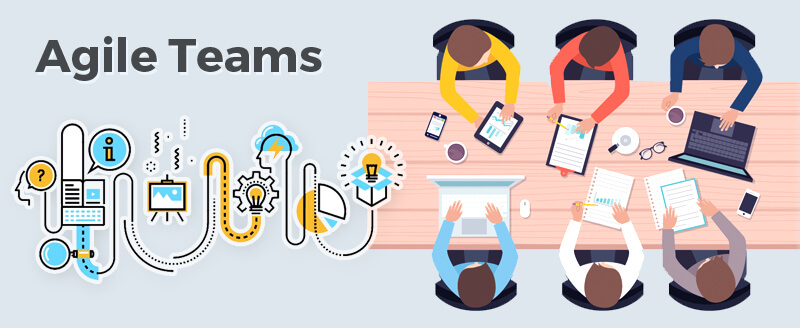“Never doubt that a small group of thoughtful, committed people can change the world. Indeed. It is the only thing that ever has.” –Margaret Mead
Agile methodology, with its sharp planning strategies and high success rate, has witnessed a tremendous upsurge in its popularity last few years. The business world has wholeheartedly adopted this scalable, profitable and versatile method. Everybody wants to win; everybody wants to create a perfect agile team working in a perfect Agile process.
Only, it is not as simple as it sounds.
You may have an idea, resources and all the money in the world to build an awesome project, but it’s your team and the effectiveness of your Agile process that holds the complete power to make or break your project.
We have been providing successful agile teams to global organisations since decades and here’s what has helped us develop as one of the leading Agile development companies. Hope it can help you too!
1. Aim for an Autonomous and Self-organising Team
There is nothing that beats a self-sufficient team.
Give your team members power to utilise their expertise and skills to the fullest. Encourage them to take impromptu measures rather that sticking to the laid out plans. Train them to take initiatives and do more than just completing the tasks in hand. Allow them to take suitable and actionable decisions for the good of the project.
Raise an autonomous team rather than promoting a group of yes sirs.
2. Pick the Right Agile Model for your Project
Different projects support & compliment different Agile models based on their nature. Pick the most fitting one.
You are allowed to play with the different sets of agile concepts for different projects. Agile XP or Scrum, Lean development or whatever, pick the approach that best suits the project in hand. In Classic Informatics, we like to try our hands with different base factors for the same model. For example, for projects that are focused on time to task completion, we use time estimates as measuring component whereas, for projects with a high focus on the quality of execution and different priorities on different stories, we like to use story points.
3. Hold Short, Sweet and Super-effective Meetings
Regular meetings (scrum, sprint refinement, retrospectives & more) are essential to make any agile project a successful one. It helps channelise better communication within the team, monitor progress, map the road ahead, and dig out and correct any roadblocks witnessed in real-time.
But tackling the list of things stated above would mean a super-long meeting (even longer if the team is quite large), right? Honestly, the answer is no.
Train yourself to use simple yet effective Agile hacks. As an example, we use printed cue cards. Hand them out to the assignees and ask them to write 3 points each for the ‘completed subtasks’ and ‘to-do’s’, and then go for the scrum meeting. It’s easier, effective and a lot time-saving.
One such other example that we use is JIRA to Slack notification integration. We have configured notification of important events in JIRA to be automatically pushed into Slack channels. This method allows team members to be updated in real time about sprint progress without having to invest time asking and waiting for responses.
Don’t drag the meeting unnecessarily. Just review, discuss, resolve, and move on.
4. Avoid Going for Long Sprints Unless Absolutely Necessary
Longer sprints, while being thorough, carry a higher risk of deviating from the original objectives and planned outcomes. For release critical & strictly time-bound projects, longer sprints are the real killers. You start, you execute, then you get lost and then start re-doing stuff.
The best plan is to adopt shorter sprints with much value for time and delivery approach. Take a feasible time-frame (usually 2 weeks to 4 weeks) and execute tasks according to set time estimates or story-points. It also creates a psychological impact as everyone knows that time is short and it’s not affordable to slack off; thereby increasing team productivity.
With that said avoid making your sprints super-short also as it invites fatigue, takes away breathing space from the team and appears chaotic that can’t be easily managed.
5. Swap Individual Responsibilities with Teamwork
While it comes under ‘Agile’ framework, your agile team is just what it is- a team. It may have individuals with individual talents, skills, expertise, and roles, but at the end, they all work together to achieve one target.
Create an environment that isn’t entirely focused on individual responsibilities but on the team as a whole where everyone is accountable for the project in hand. By doing this, you’ll be ensuring a complete transparency in the system and everyone in the team will be able to recognise their efforts.
6. Befriend Automation
Leverage the powerful of automation processes for a smooth and successful sprint.
Rather than wasting time on process related facilitation, allow your team to get the real work done. Automate everything else. There are several applications that are solely focused on automating the Agile process; take Atlassian JIRA for example. They have taken Agile automation to a whole new level. This would enhance actual work done in the designated time slot and at the same time keep the team engaged & interested.
By implementing one such automation, that is one-click, single point access to entire project inventory for our teams, we have increased our sprint productivity by more than 30%. Just like that. Simple but powerful, isn’t it?
Creating a simple but powerful agile process can be a bit tricky, but not entirely impossible. You need to pay attention to minute details, align them with your project requirements and build an agile team that is both productive and inspiring.
It will take some time, of course. And patience- a lot of it.
Good luck!

Written by Tanya Kumari
Tanya leads the Digital Marketing Team at Classic Informatics, a leading web development company . She is an avid reader, music lover and a technology enthusiast who likes to be up to date with all the latest advancements happening in the techno world. When she is not working on her latest article on agile team dynamics, you can find her by the coffee machine, briefing co-workers on the perks of living a healthy lifestyle and how to achieve it.



















